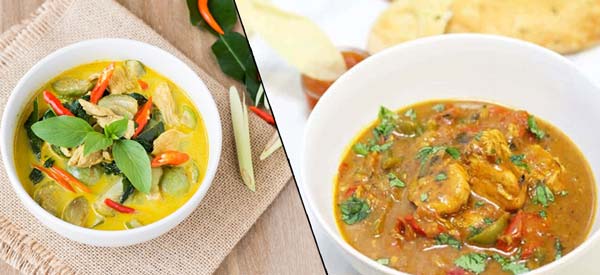SeaRanchLodge.com is a participant in the Amazon Associate program and will earn from qualifying purchases.
For those of you who love all things spicy, curry must be among your top favorites in dinners or special occasion meals! If you are unfamiliar with it, curry is basically a spicy gravy complemented by other mouth-watering ingredients like vegetables and eggs. It usually looks yellowish to orange in color because of its spicy content.
The two most popular variations of this delicious dish come from south-east Asian countries – India and Thailand. They both may seem synonymous to people who are not used to curries or who have never tried either. However, they actually have subtle differences!
We will explore those differences, as well as the similarities today by comparing Thai curry vs Indian curry. So get your spoons and bowls ready!
For more cooking tips, check out here.
What is Thai Curry?
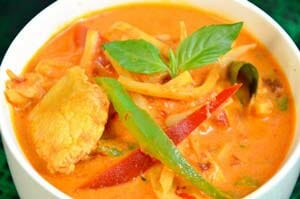
The curry originating in Thailand is a paste of several spices, herbs, meat, and more. This versatile concoction makes it like an explosion of flavor in your mouth while also providing you with some essential nutrients! You will often find other scrumptious additions to the curry-like coconut milk, seafood, and even fruits!
A good Thai curry usually takes about 30 to 40 minutes to prepare. However, there is a faster way to make it if you just want to try this curry for the first time out of curiosity.
All you need is rice along with meats and vegetables of your liking. Of course, the usual essentials like oil, salt, and spices will also play a role.
Why Should You Try Thai Curry?
Healthy Ingredients
The best part about Thai curries is that you can meet your cravings without compromising too much with your health!
You don’t have to deal with processed carbs or similar harmful elements while enjoying a hot bowl of fresh curry. It mainly has natural ingredients like rice, meat, fish, eggs, and vegetables.
Whatever you add to the original concoction usually does not exceed the daily recommended portions of each nutrient. The meat or fish content will provide you with protein which helps to build muscle mass. Eggs are another source of protein and fats, also bringing in the benefits of vitamins and good cholesterol.
Spices like turmeric, cinnamon, garlic, and others contribute to improving your overall health. They lower harmful levels of blood sugar, boost cardiovascular health, combat inflammation, and help to avoid nausea.
Light Gravy
The consistency of Thai curries is similar to that of soup. It is a very thin gravy that brings out the flavor of its meat and vegetables even better. For those of you who are not used to having spicy dishes, these curries can be a good starting point. Thai curry is much easier on your stomach than other alternatives.
Taste Variations
Although it is the same dish at its core, there are many variations to Thai curry in terms of cooking style and ingredients. As a result, they all lead to different tastes that hit your tastebuds in very distinct ways. You can make it spicy, sweet or sour according to your preferences.
Colorful Variations
Along with a variety of tastes, the Thai curry also allows you to add a color of your choice to the dinner table! You can cook the red, green or yellow version of this delectable cuisine to impress your guests. The green one is the hottest one, red is a little less spicy and the yellow one is actually the least peppery among the three.
What Are The Downsides Of Thai Curry?
A lot Of Calories
While a bowl of Thai curry will definitely satisfy your cravings and tastebuds, it also adds lots of calories to your daily diet. Just one cup of these curries amounts to over 400 calories! The reason behind this huge number is the heavy portion of coconut milk used in each bowl.
Saturated Fat
Another health risk of indulging in Thai curry on a regular basis is its high content of saturated fat. One cup of this creamy curry usually comes with 43 grams of saturated fat which is already thrice the recommended amount for daily intake. This may lead to higher levels of LDL or bad cholesterol and put your heart at risk.
What Is Indian Curry?
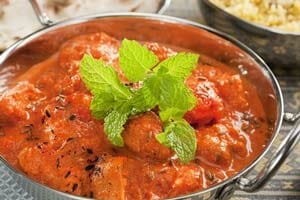
Another country where curry dominates the daily menu is India. Every state here has its own rendition of the popular dish. For instance, the Northern areas like Gujarat use coconut milk or buttermilk to make the gravy more delicious. They rely heavily on vegetables to bring out the best of curries.
It has been an integral part of their eating habits since the days of British colonization. Preparing it will take you half an hour at least.
You can use any meat of your preference in it – lamb, chicken, beef, or something else. There are separate recipes for each of them to enhance their flavor even more.
Why Should You Try Indian Curry?
Both Veg and Non-Veg Varieties
A great aspect of Indian curries is that it also provides vegans and vegetarians a chance to indulge in the delicious taste. If you follow this approach in life, you don’t have to compromise with your values only to enjoy a spoonful of spicy goodness.
On the other hand, if you love meat and fish, you can also dive into a bowl of Indian curry and make the most of its mouth-watering flavors. There are different Indian curry recipes dedicated to bringing out the best taste of each meat. You can also put your own spin on it if you want!
Thick Gravy
The gravy of Indian curry is pretty thick since it is made from curry pastes. So if you like a dense consistency for gravies to comfortably dip bread pieces, snacks, and similar items into, this is the one to go for! And of course, it tastes the best with other regional foods like rice which mixes well with such gravy.
Moderate Calories
You don’t have to worry too much about going overboard with your calories while enjoying the Indian curry. When cooked properly, one serving of these curries usually doesn’t amount to more than 150 to 200 calories. As a result, you can easily fit them into your diet while not giving up the amazing flavors.
What Are The Downsides Of Indian Curry?
Dairy Ingredients
Coconut milk is seldom used in Indian curry. The common substitute for it in this part of the continent is ghee or clarified butter. Besides, half of the content in ghee is saturated fat. So it may not be ideal for non-dairy diets and its saturated fat can lead to poor cardiovascular health over time.
Too Hot By Itself
Unfortunately, most Indian curries are not supposed to be served by themselves. Their high spicy content makes the curry nearly impossible to eat without something like rice, flatbread, or similar items. So you cannot call it a day after only preparing the curry. You will also need to have the other items ready to go for the meal.
Difference Between Indian Curry Vs Thai Curry
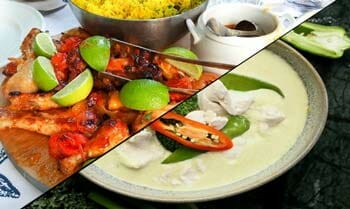
Thickness
The consistency of Thai curries is slightly lighter than that of Indian ones. There are also some versions of the Thai curry which look like soups. You can have them without the need to dip something into the curry. In contrast, Indian curries look and feel more like stews than soups.
Use Of Spice
Although both Thai curry and Indian curry are known for their use of spices, the latter uses them in a larger amount.
The spices used in Indian curries include turmeric, cumin, coriander, cardamom, fenugreek, saffron, mustard seeds, Asafoetida or hing, and of course the very popular Garam Masala. On the other hand, Thailand uses garlic, cinnamon, cloves, cumin, and turmeric.
Thai curries use a lot of herbs like lemongrass and basil in addition to those spices. Because of this balance between herbs and spices, Thai curries don’t use the latter in huge amounts.
Dairy Content
Like most Indian dishes, their curries too include a hefty amount of ghee. It can also have heavy cream or sauces based in yogurt to make the curry even more creamy. Thai curries almost never use dairy ingredients. They usually rely on plant-based sources like coconut milk to make their dishes.
Freshness
The preparation of Thai curries begins with a paste made of fresh vegetables and herbs. It usually doesn’t include dried herbs or spices to cook the curry.
On the other hand, Indian curries rely on their own kind of paste which doesn’t include fresh ingredients. As a result, Thai curries bring more freshness to each meal.
Varieties
Thai curries have five major varieties like red, green, yellow, Penang, and Massaman. The green curries are the hottest, red is a little less hot, and yellow is the mildest. Panang tastes like red with an added flavor of shrimp while Massaman is the sweetest option with peanuts.
Indian curry has many renditions but the most popular ones among them include Tikka Masala, Chana Masala, butter chicken, Palak Paneer, Vindaloo, and Korma. There is something for everyone in these dishes made with fish, chicken or pork.
As you can see, there are plenty to choose from both Indian curry and Thai curry. While Thai curries are mostly classified based on their hotness, Indian ones are categorized based on their major ingredients.
Side Dishes
There are some Thai curries that you can consume without needing a side dish. Since these particular curries have a thinner consistency, you can have them as your morning or evening soups.
Unfortunately, the same cannot be said about Indian curries which are much thicker and spicier. You must have them with rice, flatbread, or something similar to balance the flavors and make it easier on your mouth.
How to Make Indian Curry Soup (For Beginners)
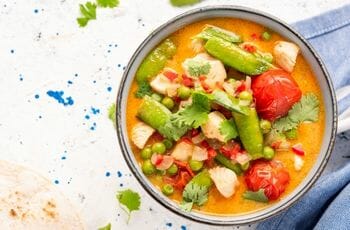
Here is a step-by-step guide on how to make Indian curry soup:
Step 1: Gather the common ingredients: onions, garlic, ginger, and additional spices. Chop the onions and garlic and mince the ginger. Heat oil in a large pot and add the onions, garlic, and ginger. Cook until they are softened and fragrant.
Step 2: Add a few tablespoons of your favorite curry powder and any other spices you like. For a richer flavor profile, choose dried herbs such as coriander, cumin, turmeric, and garam masala, or add fresh spices such as cardamom pods or cinnamon sticks. Stir everything together until the spices are fully incorporated and fragrant.
Step 3: Add some vegetables of your choice. You can use anything from potatoes and carrots to bell peppers, squash, and green beans. Cook for a few minutes until the vegetables are softened.
Now, add some broth or stock to the pot. Depending on your preference, you can use water, chicken, or vegetable stock. Bring the soup to a boil, then reduce the heat to a simmer.
Lastly, add some cooked lentils or beans of your choice. This will give the soup a thick and creamy texture. Then simmer for 15-20 minutes, stirring occasionally.
When it’s done, season with salt and pepper to taste, and your Indian curry soup is ready to be enjoyed. Serve it with some fresh cilantro and a dollop of yogurt or cream.
How to Make Thai Curry Soup
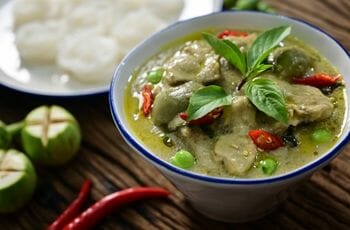
Thai curry soup is a delicious and easy-to-make dish, and it’s great for lunch or dinner. It’s a great way to warm up on a cold day, and the combination of coconut cream, curry paste, and vegetables makes it flavorful and nutritious.
Here’s how to make your Thai cuisine at home:
First, gather your base ingredients. You’ll need a can of coconut milk, vegetable or chicken broth, a red, green, or yellow curry paste, a can of diced tomatoes, some vegetables (such as mushrooms, bell peppers, onions, carrots, and snow peas), and chicken, shrimp, or tofu.
Next, place a large pot over medium heat and add a tablespoon of oil. Once the oil is hot, add your vegetables (except for the snow peas) and cook for about 5 minutes, stirring occasionally.
After the vegetables are softened, add the curry paste and stir for a minute or two. Pour in the coconut milk and broth and bring the soup to a boil.
While boiling, reduce the heat to low and add the diced tomatoes, protein, and snow peas. Then simmer for 8-10 minutes.
After cooking, taste it and adjust the seasoning if necessary. You can add more curry paste or a pinch of salt and chili pepper to taste. Serve the soup with a side of cooked rice or noodles and enjoy!
The Best Side Dishes for Thai Curry Soup
Here are some of the best side dishes to pair with Thai curry soup.
Rice
Thai curry with rice is a classic meal you’ll enjoy. Whether you opt for white, brown, or aromatic jasmine rice, combining the creamy soup and the fluffy grains provides a simple yet satisfying flavor.
Naan
Naan is a type of Indian flatbread that is an excellent accompaniment to Thai curry soup. The buttery texture and slightly sweet flavor of the naan pair perfectly with the creamy, spicy flavors of the soup.
Green Salad
For a light and refreshing side dish, a simple green salad with a light vinaigrette dressing is a great accompaniment to Thai curry soup. The salad’s crunchy texture and the dressing’s tart flavor provide a nice contrast to the creamy soup.
Fried Plantain
Fried plantain is a traditional side dish for Thai curry soup. The sweet and salty flavor of the plantain pairs perfectly with the spicy flavors of the soup.
The Best Side Dishes for Indian Curry Soup
Naan
This delicious, fluffy flatbread is an absolute must-have to combine with the brighter flavor of Indian curry soup. It’s perfect for dipping into the sauce and getting every last drop of flavor.
Basmati Rice
Soft and fragrant Basmati rice is a great accompaniment to Indian curry soup. This long-grain rice helps to soak up the flavorful broth.
Raita
This cooling yogurt-based side is a great way to balance the heat of the hot curry. Add some diced cucumbers, tomatoes, and onions for extra flavor.
Samosas
These fried dumplings are filled with delicious vegetables and spices. They’re great for dipping into the curry broth and adding a little bit of extra flavor.
Final Words
While both the curries look almost similar and come from the same continent, the flavors and varieties differ. Hopefully, our guide on Thai curry vs Indian curry has provided you with ample information on that.
If you are actively avoiding dairy ingredients, Thai curries make the better choice. To avoid meat and fish, choose vegetarian Indian curries for a flavorful meal.
But if you are a foodie, feel free to dive into either one and enjoy every bite! Both of them definitely makes for a great time despite the differences.
Recommended article to read here at Sea Ranch Lodge:


